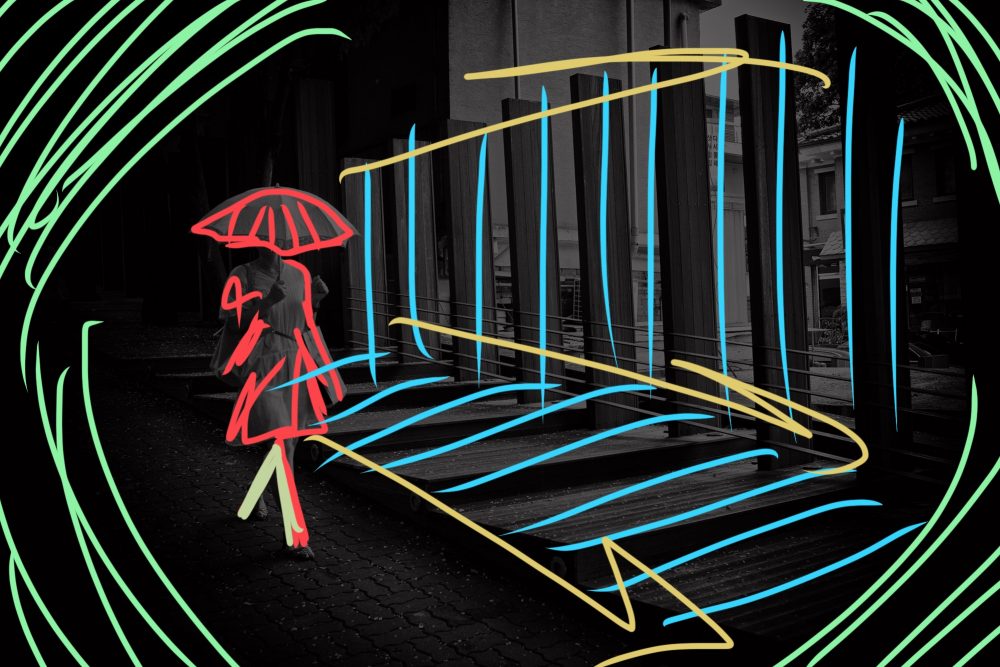Use ‘Gaussian Blur’ to better determine your compositions in photography:
Why Gaussian Blur?

Gaussian Blur: better helps you determine the “figure to ground” of a photograph [contrast].
The basic notion is this:
Create separation/contrast between your subject and the background.
The more your subject can “pop” from the background, the better.
The test


The test is simple:
- Apply Gaussian Blur to your photograph
- See if the photograph “pops” from the background
- Draw in the composition, to better get a sense of the proportions of your composition.




What we are looking for


We are striving towards the optimal “simple” composition.
Furthermore, by applying Gaussian Blur to your photos, you better understand your compositions.
Inverse + Gaussian Blur
Another tip:
Inverse your photo, then apply the Gaussian Blur.
This further abstracts your images, and helps you even better understand your compositions.


Sketching your compositions





Another idea:
Take a composition you like, then use an app like ProCreate [iPad] to fill in the blurry portions of your frame, to better understand the geometry/proportions of your frame.


Then turn your composition layers into an animated GIF, to better understand the composition.

No glasses test
Another thought:
Look at your photos without having your glasses on [to simulate the “gaussian blur”]
Or if you have good eyes, cover one eye, and squint the other one.
Or look at your photos as small thumbnails to better determine the composition.



Blur is good










Blur more of your photos [Gaussian Blur after the fact], or blurry out-of-camera!
- Shoot out of focus photos intentionally
- Photograph moving subjects [while you are standing still]
- Photograph stationary subjects as you are moving
- Photograph moving subjects as you are moving
- Photograph stationary subjects while intentionally pulling your camera toward the frame or away [slow shutter speed].










Anti-perfection
Blur is better. Why? Photos become more “imperfect”; which are more beautiful.
SHOOT ON!
ERIC
COMPOSITION

Master composition for yourself:
Street Photography Composition Tips

- The Superman Low Angle Perspective Photography Composition Effect
- High Angle Perspective Street Photography Composition Technique
- How to Shoot Low Angle Perspective Street Photography Composition Technique
Photography Composition Concepts

- How to Teach Yourself Photography Composition
- Composition vs Aesthetics in Photography
- 10 Simple Composition Tips to Make Better Photos
- How to Compose a Photograph
- Edge Detection Photography Composition
- Vector (Arrow) Photography Composition
- Clear and Obscure (Chiaroscuro) Photography Composition
Photography Composition Tips

- How to Photograph Motion
- Photography Composition: Which Direction is Your Subject Looking?
- Blocking Technique in Photography
- How to Shoot a Triangle Photography Composition
- How to shoot a golden triangle composition in street photography
- 8 Simple Curve Composition Tips
- 5 Simple Henri Cartier-Bresson Composition Tips
- Foot Zoom
- Photography Composition: Light and Dark
- Street Photography Composition Lesson #16: Scale
- Shape, Arrangement, Position (S.A.P.) and Contour, Inter-Contact, Position (C.I.A.) in Photography
- 10 Tips How to Fill the Frame in Photography
- Look Up! 16 Photography Composition Perspective Tips
- 5 Simple Street Photography Composition Tips
- Depth Perception
- Golden Angle Composition in Street Photography
- Photographer as an “Arranging Artist”
- Dynamic Off-Center Street Photography Compositions
- 5 Essential Composition Tips in Photography
Color Theory

- Red and Green Composition Color Theory For Photographers
- The Ultimate Beginner’s Guide to Color Photography
- Opponent Process Color Theory For Photographers
- Color Theory For Photographers
- Color Manual
- How to Shoot Color Street Photography
Learn From the Masters of Composition

- 10 Lessons Matisse Can Teach You About Art and Life
- Henri Cartier-Bresson Composition
- 10 Timeless Lessons Edward Weston Can Teach You About Photography
- 10 Inspirational Sergio Larrain Compositions
- 5 Henri Cartier-Bresson Photography Composition Lessons
Dynamic Photography Composition 101

- Introduction to Dynamic Photography Composition
- How to Visually Analyze Your Photography Compositions
- Dynamic Tension: Opponent Based Theory For Photography
- Opponent Process Color Theory For Photographers
- Dynamic Photography Composition 101: Figure to Ground
Painting Compositions

Dynamic Photography Composition Tips

- 7 Simple Photography Composition Tips
- How to Make Aggressive Photography Compositions
- 10 Dynamic Photography Composition Tips
- How to Make More Dynamic Picture Compositions
- Unorthodox Photography Composition Techniques
- Deconstructed: Saigon Eric Kim Photos
Composition Theory

Take your composition to the next level:
- Gestalt Theory
- Juxtaposition
- Center Eye
- Low-Angle
- Dutch Angle
- Deep Depth
- Spacing
- Silhouette
- Leading Lines
- Figure to Ground
- Fibonacci Spiral
- Cropping
- Emotion
- Composition by Eric Kim
Street Photography Composition 101

For distilled lessons on composition, read the free ebook: “The Street Photography Composition Manual.”
Further articles to improve your compositions in photography:
- Composition Lesson #1: Triangles
- Composition Lesson #2: Figure-to-ground
- Composition Lesson #3: Diagonals
- Composition Lesson #4: Leading Lines
- Composition Lesson #5: Depth
- Composition Lesson #6: Framing
- Composition Lesson #7: Perspective
- Composition Lesson #8: Curves
- Composition Lesson #9: Self-Portraits
- Composition Lesson #10: Urban Landscapes
- Composition Lesson #11: “Spot the not”
- Composition Lesson #12: Color Theory
- Composition Lesson #13: Multiple-Subjects
- Composition Lesson #14: Square Format
Composition Theory

Learn compositional theory:
- Why is Composition Important?
- Don’t Think About Composition When You’re Shooting Street Photography
- How to Use Negative Space
- Street Photography Composition 101
- The Theory of Composition in Street Photography: 7 Lessons from Henri Cartier-Bresson
Compositional lessons from the masters of art
Composition lectures
Composition pictures/grids


Golden Diagonal Composition

























